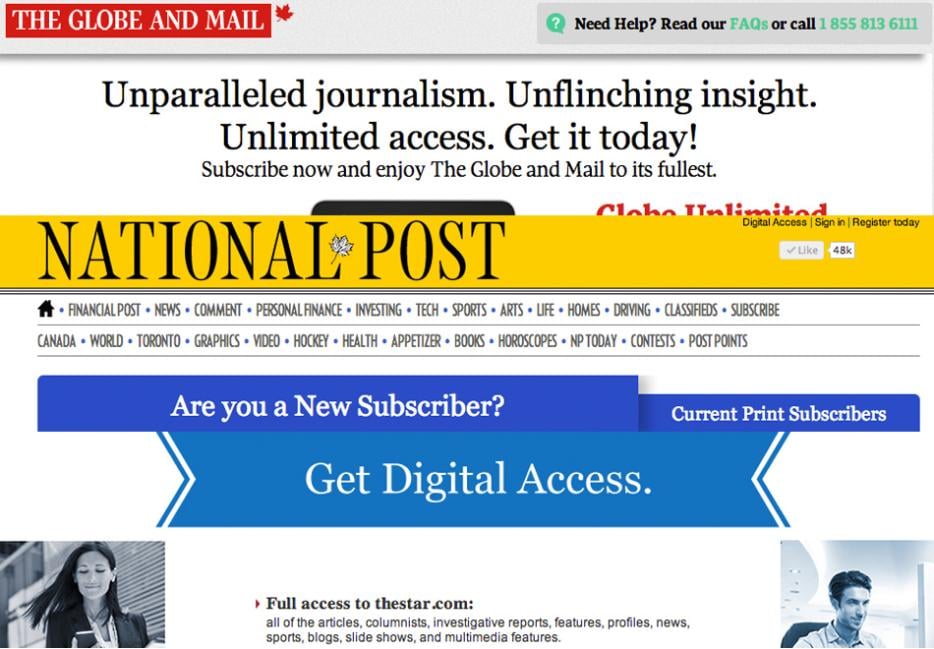A bold prediction: Now that the Toronto Star, Canada’s most circulated newspaper, has joined the national dailies in instituting a paywall to—gasp!—make us pay for the news, digital news readers will soon become like all other fanboys and girls on the Internet.
This sort of fervent defense of brands and companies has, of course, plagued the world of digital technology for years. But now, online news sites and tech will share one key aspect that helps explain the pernicious phenomenon: When we make an financial investment in a thing or a company—like, say, buying an Xbox, or ponying up to read the Globe and Mail or the National Post—we feel compelled to defend it. That simple fact may not only promote a kind of blind loyalty amongst readers, but it might also end up hurting the social function of news in the process.
When media went digital, one of the most immediate and lasting effects on news was that it became atomized. As a result, aggregators quickly popped up, whether things like Google News that sifted through those scattered pieces, or more intriguing, attractive concepts like Flipboard. The latter is part of a shift toward thinking about forms of news consumption that don’t represent individual editorial organizations, but rather a method of gathering numerous voices into a “publication” that thinks of itself as more of a personalized, customizable magazine.
Paywalls, on the other hand, because they are designed to encourage loyalty, emphasize singular, closed editorial entities—traditional magazines, newspapers, etc.—that tend to represent a more coherent, similar set of viewpoints. It’s the contrast between homogeneous and heterogeneous perspectives that is actually the key tension between more familiar news organizations and the algorithmic- or app-based approach that has come to define the novelty of “digital news.”
You can argue about whether that “aggregation” is symbiotic or parasitic until you’re blue in the face. But if paywalls are seen by the news industry as a defense against the atomizing power of the web, a perhaps overlooked aspect of them is their psychological impact. Once you invest in something, you become, well, invested. As a post on the great blog You are Not So Smart highlights, the tendency toward fanboyism comes from a need to rationalize to yourself the choices you’ve made. If you dropped $500 of your hard-earned money on an iPad, then that schmuck online shouting about how much Apple sucks isn’t just attacking a technology company, he’s also attacking people like you who decided to buy one.
So what happens when dedicated newshounds realize they must pay to read the news? For one, individuals are far more likely to invest in the news and opinions that best represent the views they already have, continuing but perhaps also concentrating the ideological alignments of readers and publications. Once, however, people have made that decision, they will likely also find themselves in the role of the fan, looking for reasons to justify that purchase to themselves. If a columnist whose work was one of the reasons you were willing to pay for access makes an argument, are you more or less likely to accept evidence that what they’re saying is wrong? Adding money into the web news equation complicates the already messy dynamic of reading to justify what we already believe.
Paywalls could thus also exacerbate the feedback loop between the ideological bent of a publication and the views of its readers. It’s not so much that subscribers will stop reading other outlets or perusing the wider web entirely, as much as there will be a psychological compulsion to stick with what you’ve paid for—a situation that could arguably counter the best of digital news. One of the things digital media has lent itself to well has been the serendipitous or social introduction to things outside your normal experience. This feature can be oversold, of course—we know that the customizability of the web can be used to circumscribe and limit views as well. But paywalls add a mental dimension to the mix of choosing what to read, what to accept, and what to reject, inadvertently helping to reproduce the very political silos the web was, at least in theory, supposed to help break down.
Given the economic pressure on “old media,” however, simply doing away with paywalls isn’t quite an option, either. Ideally, perhaps we could put paywalls in front of curated, diverse aggregators rather than individual publications, in effect asking people to invest in the social function of news rather than just the entities that produce it. The economics of such a proposition are, of course, nowhere near tenable. Unfortunately, like so many other circumstances engendered by digital media, the only choices all look a heck of a lot like rocks and hard places—and things will probably only get more unpleasant before anybody finally figures out what this is all supposed to look like.






